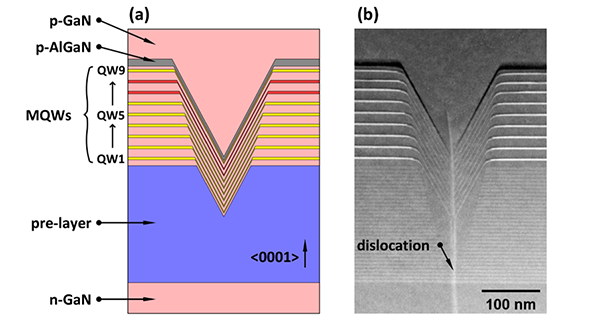InGaN-based materials have broad application prospects in visible light range due to its tunable wide band-gap. Micro size light emitting diode (micro-LED) display is one of the most promising applications. Future smart phones, watches, virtual reality glasses, and other small screens will benefit from micro-LED technology.
The micro-LED technology faces two great challenges, one challenge is known as massive transfer, and the other challenge is the lacking of efficient and reliable red micro-LEDs. The current red LEDs are made of AlGaInP materials with high efficiency above 60% in normal chip size. However, when the chip size is reduced to micro meter, its efficiency decreases dramatically to less than 1%. The drop of efficiency can be attributed to the strong surface recombination associated with long diffusion length of holes in AlGaInP materials. Besides, the poor mechanical property of AlGaInP materials adds new difficulty to the mass transfer process, which requires good mechanical strength to avoid chip cracking during the pick and place process.
The InGaN material has better mechanical stability and shorter hole diffusion length, which is a good candidate for red micro-LED, and it also compatible with current InGaN green and blue micro-LEDs. However, the InGaN-based red LEDs suffer from indium segregation problem, which will lead to an increase in non-radiative recombination in the red quantum wells (QWs) and decrease in efficiency. In the past two decades, the power conversion efficiency of InGaN-based red LEDs was reported to be less than 2.5%. The problem of indium segregation has seriously hindered the development of InGaN-based red LEDs. Therefore, how to solve the problem of indium segregation is the key to obtain efficient InGaN based red LEDs.
The research group led by Academician Prof. Fengyi Jiang from Nanchang University demonstrated their latest research result on efficient InGaN-based orange and red LEDs, which is now published in Photonics Research, Volume 8, No. 11, 2020 (Shengnan Zhang, Jianli Zhang, Jiangdong Gao, et al. Efficient emission of InGaN-based light-emitting diodes: toward orange and red[J]. Photonics Research, 2020, 8(11): 11001671).

Schematic diagram of the epi-structure (a) and cross-sectional TEM test results (b) of efficient orange LED
In this work, based on GaN/Si technology, by introducing alternative red and yellow QWs, and combining the technology of V-pits, the problem of high indium content segregation in the red QWs is greatly alleviated. And with the help of V-shaped p-n junctions and QWs band gap engineering, the radiative recombination in the red QWs is greatly enhanced. A series of efficient InGaN-based orange and red LEDs were successfully fabricated with power conversion efficiency of 30.1% at wavelength of 594 nm, 24.0% at wavelength of 608 nm, and 16.8% at wavelength of 621 nm. These values are about ten times higher than those of the previous reports on InGaN-based orange and red LEDs.
The researchers believe that this technology will have large advancement in near future. The results demonstrate the great potential and beautiful perspective of InGaN materials to be used as red pixel for full-color micro-LED display.


